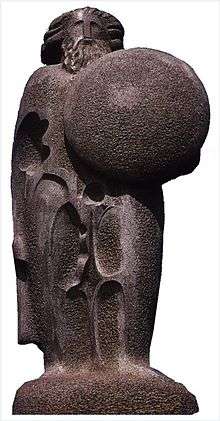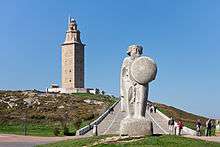Breogán


Breogán (also spelt Breoghan, Bregon or Breachdan) is a character in the Lebor Gabála Érenn, a medieval Christian pseudo-history of Ireland and the Irish (or Gaels). He is described as a king of Galicia and an ancestor of the Gaels. The Lebor Gabála purports to be an account of how the Gaels descend from Adam through the sons of Noah and how they came to Ireland. It tells us that they spent 440 years wandering the Earth and underwent a series of trials and tribulations, which is based on the tale of the Israelites in the Old Testament. Eventually, they sail to Iberia and conquer it. There, one of their leaders, Breogán, founds a city called Brigantia and builds a great tower. From the top of the tower, his son Íth glimpses Ireland. The Gaels, including some of Breogán's sons, sail to Ireland from Brigantia and take it from the Tuatha Dé Danann, the Irish pagan gods. Brigantia likely refers to A Coruña in Galicia (which was then known as Brigantium)[1] and Breogán's tower is likely based on the Tower of Hercules (which was built at A Coruña by the Romans) or the Tower of Babel. The idea that the Irish Gaels came from Iberia may be based on the similarity of the names Iberia and Hibernia and the names Galicia and Gael.[2] Medieval pseudo-historians made similar claims about other nations based on their names.[3] A similar story about a monk who voyaged to a marvelous island he saw from the top of the tower of Brigantia was written in the first years of the eleventh century in Galicia. The story, preserved in two 14th-century manuscripts, is known as Trezenzonii de Solistitionis Insula Magna ("Trezenzonius' Great Island of the Solstice").[4] His son was Bile, who was in turn the father of Milesius (also called Míl Espáne, soldier of Hispania or Spain), said to be the ancestor of the Irish people.
The Lebor Gabála was a hugely popular and influential work. Galicia itself is sometimes described poetically as the "Home" or "Nation" of Breogán (in Galician, the fogar or nazón de Breogán). The land is so described in the anthem of Galicia, "Os Pinos". A large statue of Breogán stands near the Tower of Hercules in Coruña. In Madrid, Spain's capital, there is a park called Parque de Breogán, named after Breogán.
References
- ↑ Encyclopaedia Britannica, "A Coruña".
- ↑ Monaghan, Patricia. The Encyclopedia of Celtic Mythology and Folklore. Infobase Publishing, 2004. p.332
- ↑ Carey, John. The Irish National Origin-Legend: Synthetic Pseudohistory. University of Cambridge, 1994. p.13
- ↑ Bloom, James J. (2013). The imaginary sea voyage : sailing away in literature, legend and lore. p. 69. ISBN 9780786465255.
External links
![]() Media related to Breogán at Wikimedia Commons
Media related to Breogán at Wikimedia Commons
- Historical timeline of the Tower of Brigantia, whence the Milesians left for Ireland
- Why is Galicia Breogan's Nation?